The oldest profession
What is a zoologist? The story of the oldest profession in the world told by Marco Oliverio.
The thin rain soaked everything in the forest of the Eastern Highlands of New Guinea in 1965, even the notebook in which a young American naturalist is taking notes, who joined an expedition organized by the American Museum of Natural History to collect data and specimens for the museum. The young naturalist deals with ornithology and is no longer surprised by the extraordinary ability of his companion to identify birds from just their song; The chaperone is from the village of Awande, part of the Fore people. As often happens with the peoples who live in these parts, the Fore have extraordinary knowledge of nature and practice the art of cataloguing living organisms with wisdom, assigning them a name, essentially biological Taxonomy. The level of overlap of their bird taxonomy with that of Western specialists (for example, the one adopted by the famous Ernest Mayr, in his “List of New Guinea Birds”,1941) is surprising. The young naturalist is Jared Diamond, who won the Pulitzer Prize for nonfiction with “Weapons, Steel and Diseases”, 1997), who will write an article in the journal Science in 1966 on the ornithological taxonomy of the Fore.
Diamond’s observations in New Guinea suggest the theme of the “emergent naturalness” of biological species, which are identified and inventoried substantially in the same way by all cultures on the planet. They are realities of nature that man perceives as such, gives him a name, catalogues them: that is, he works the inventory of biodiversity, or the multitude of forms of life on the planet. He does it practically everywhere; he has been doing it for a long time, perhaps always, since he began to use language and to associate phonemes with objects of the surrounding reality. This is how the fact comes to light that the naturalistic taxonomist, the author of the inventory of biodiversity, is the true oldest profession in the world. [… What did you think? The idea that the oldest profession of the fashion is that of the harlot is nothing but anecdotal, and quite recently, going back to a novella by Rudyard Kipling (“On the City Wall”, 1889) on Lalun, a young Indian prostitute, of which Kipling says: “Lalun is a member of the most ancient profession in the world”].
Nothing but a shepherd, a carpenter, or a farmer. To give credit to the chronology illustrated in the pages of Genesis:
“Then the Lord God formed from the ground all kinds of wild beasts and all the birds of the sky and led them to man, to see what he would call them: whatever man called each of the living beings, that would be his name. So, man named all the cattle, all the birds of the sky, and all the wild beasts.” (Genesis 2: 19, 20)
Here the Lord God commissioned Adam to give a name to living creatures, that is to make the Taxonomy of Biodiversity. It is, if you think about it, the only ˈcraft’ that is said to have been explicitly assigned by the Creator to man in the Garden of Eden, before the expulsion and the curse of work.
And it is not only Christianity that tells us that Taxonomy begins so early in human history.
About 20 years after Diamond recounted his experiences with the native taxonomists of New Guinea, Bruce Chatwin (1987, “Songlines”) told the world about the Australian Aboriginal myth of creation: narrates, Chatwin, by Barnumbirr (identified by some with Venus, the Morning Star), the legendary totemic being, the spirit-creator who, hovering over the continent in the Time of Dreams, sang the name of everything – animals, plants, rocks, pools of water – and so on. By chanting the name, the things of nature came into existence.
Leaving aside the centuries and millennia of taxonomies carried out by man all over the planet, the modern work of inventory of Biodiversity, that is modern Taxonomy, as much as possible coordinated on a global scale, begins by convention with the 10th edition of the “Systema Naturae” by Carl Nilsson Linnaeus, dated, again by convention, 1 January 1758. Since then, specialists of various groups of living organisms (animals, plants, fungi, bacteria, etc.) have catalogued perhaps 2 million species. They may seem many, or few, with an uneven distribution on the planet. In Italy, which is a country rich in biodiversity, for example, there are about 60,000 species of animals and 8,000 species of plants. The problem is that every year, every month, every day, new species are discovered, described, and catalogued in all groups of organisms: these are residual discoveries, which leave the total number as a plausible reference of the existing reality? Or are we still far from the goal?
Terry L. Erwin, a beetle specialist – the largest group of insects, and insects are the largest group of animals – at the National Museum of Natural History in Washington, in 1987 tried to estimate the actual number of existing species, extrapolating it from his in-depth data on the forests of Panama, and he found a number that stunned the world of naturalists: 30 million species! Other insect specialists, such as Nigel E. Stork (London’s Natural History Museum) or Vojtech Novotny (Ceske Budejovice’s Czech Academy of Sciences), tried other calculations, estimating lower but always very high numbers: from 4 to 7 million insects, corresponding to about 10 million species of living organisms. Finally, more recently, with the availability and coverage of global data offered by the internet, Carlos Mora and colleagues (2012) have produced a very accurate estimate of just under 9 million existing species (8.7 million to be exact) of which 2.2 million in the oceans. If Mora and colleagues’ estimates are correct – and if they are not, it would be to round down – we have done one-fifth of the work in over 260 years of Modern Taxonomy, and perhaps we have intercepted the most obvious, easiest part to deal with, in the most accessible geographical areas and habitats. Mora and colleagues have also tried to estimate that to finish the inventory work while maintaining the current speed, it would take another 1,200 years, with over 300,000 taxonomists employed full time, and a purely hypothetical cost of over 360 billion dollars.
There is little to do about the needs of people and money, except for the time factor perhaps we can intervene, and in reality we must– in the next 1,200 years an important part of the species will become extinct before even being discovered. On one hand, we need a concrete commitment (resources, infrastructure) institutional, national and international, and on the other a change of pace that makes full use of the most modern methodologies and allows to accelerate a work of essential basic knowledge. Today, there are methodologies that allow to influence the time factor, integrating the most traditional approaches in the cataloguing of species (the specialist who describes the morphology, biology and ecology of the species he discovered) with data from modern technologies (from the sequencing of individual genes to characterisation of the entire genome). You can think of using the DNA sequence of an organism, first as a tool to help the specialist in deciding whether you are faced with a known species or a new one (often speeding up the decision-making process, and thus the inventory of new species); then the sequence of specific portions of the genome can be used as a recognition barcode, speeding up, if not more, the process of identifying species. It is the so-called approach of DNA-barcoding, which is revolutionising the work of inventorying biodiversity both in the exploratory part of discovery of novelties, and in the more routine monitoring of habitats.
The points of reference for these processes, in the great countries of the planet, are the National Museums of Natural History. In Italy, a young country in its current unity, but with a very strong secular tradition in the theme of Taxonomy, we have a myriad of naturalistic museums (over 400) regional, provincial, municipal and university, with collections that are often very important, true treasure troves of biodiversity, but we still lack a single reference on the national scale. At a time like this, of great investments, in which the so-called “green” issues can guide the decision-making processes in an important way, it is time to think seriously about a National Museum dedicated to the theme of Biodiversity, that promotes the most innovative research in the field, which gives new strength, a strength of modernity and tradition at the same time, to the oldest profession in the world.
Marco Oliverio, Zoologist at Department of Biology and Biotechnology “Charles Darwin” of Sapienza University of Rome





















Commenti recenti